Serviços Personalizados
Journal
artigo
Indicadores
Compartilhar
Journal of Human Growth and Development
versão impressa ISSN 0104-1282versão On-line ISSN 2175-3598
J. Hum. Growth Dev. vol.29 no.1 São Paulo abr. 2019
https://doi.org/10.7322/jhgd.157763
ORIGINAL ARTICLE
http://dx.doi.org/10.7322/jhgd.157763
A rare case of a maxillary fourth molar: Case report
Valdelias Xavier Pereira; Alan Patricio da Silva; Juliana Spat Carlesso; Marcelo Ferraz Campos
Laboratório de Delineamento de Estudos e Escrita Científica do Centro Universitário Saúde ABC, Santo Andre, São Paulo, Brazil
ABSTRACT
INTRODUCTION: The objective of this clinical case report is to describe the presence of bilateral fourth molars. The occurrence of supernumerary teeth (ST) is a relatively unusual dental anomaly. It is even more unusual to find patients with distomolar teeth also denominated fourth molar teeth.
PRESENTATION OF THE CASE: This article describes a clinical case of a 24-year-old patient presenting with a maxillary fourth molar, who was diagnosed by dental x-ray, and surgical resolution of the case.
CONCLUSION: Tooth extraction surgery was the clinical procedure chosen to treat the impacted tooth.
Key words: supernumerary teeth, fourth molar, distomolars, oral surgery
What is the purpose of this study?
It is a Radiological finding in which normally this type of anomaly does not present symptomatology and it is not possible to visualize clinically.
What researchers did and found?
They performed a protocol of treatment and surgical intervention for definitive resolution of the case.
What do these findings mean?
To report rare cases of facial skull anomalies with techniques and protocols for the treatment and correction of this occurrence, allow other researchers and surgeons to understand and resolve.
INTRODUCTION
Supernumerary teeth (ST) are those in excess above the normal number of teeth in both upper and lower dental arcade1. Their occurrence is very rare, with a prevalence in the general population of 0.1-3.8%2-5. ST are most often found in the maxilla1,3,5,6, with a higher frequency in men than women7.
The etiology of supernumerary teeth is still is unclear. Some theories for the origin of this anomaly include hereditary ailments, horizontal proliferation of dental lamina, embryologic development, and environmental factors2,5.
The most frequently affected areas are the region of the upper incisor and the region of the third molars3,7. ST from the incisor region are denominated mesiodens, those from the molar region are denominated paramolars, and those from the fourth molar region are denominated distomolars. Paramolars are rudimentary and are located in the lingual or vestibular region in relation to the alignment of the molars8.
Fourth molars or distomolars are located distally to the third molars; they have a rudimentary shape and are generally seen as retained or included teeth2,4. These teeth very rarely erupt in the oral cavity; therefore, they are normally only discovered through dental radiography9.
Early diagnosis, correct clinical assessment, and adequate clinical treatment are key factors in providing care to patients with ST10. There are two ways to treat ST: extraction11 and in some specific cases, the maintenance of the tooth in the dental arch with frequent clinical follow up12.
Supernumerary molars must be extracted when they do not erupt, when misaligned with the permanent teeth3,11, or when causing cystic injuries, sub-acute pericoronitis, gingival inflammation, periodontal abscesses, ameloblatoma, fistulae or reabsorptions of roots2,12.
The extractions must be executed carefully, and always by a dental surgeon with expertise in this field, in order to avoid damage to the dental follicle or reduction of the enamel epithelium of the roots of the permanent adjacent teeth. It is also important to avoid ankylosis or eruption of these teeth. The dental surgeon must be vigilant for potential damage such as: damage to the lower alveolar artery and nerve; jaw fracture; and perforation of the pterigomaxillary space, maxillary sinus or orbit7,9,13.
This paper reports a rare case of a patient with a maxillary fourth molar.
CASE PRESENTATION
The patient, E.D., a young man aged 24 years, came to our dentistry clinic for orthodontic treatment. He was sent to the Maxillofacial Surgery Department to undergo a clinical assessment and receive treatment for a supernumerary maxillary tooth found on dental x-rays.
The clinical assessment revealed a patient in general good health without signals of dental caries and absence of injuries in the buccal cavity (in and out). Furthermore, there was no history of occurrence of ST and/or other dental anomalies among other members of his family.
Dental Radiography
The dental x-ray revealed a fourth molar impacted by the upper-left third molar (28) (Fig. 1). The use of x-rays and linear tomography has been extremely useful for the planning of oral surgeries.
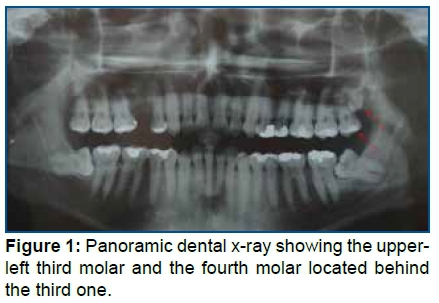
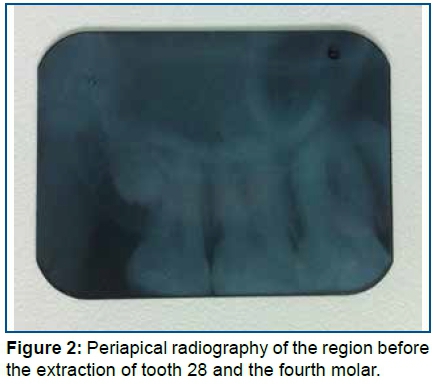
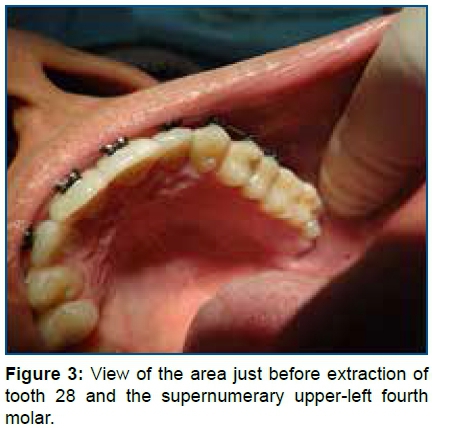
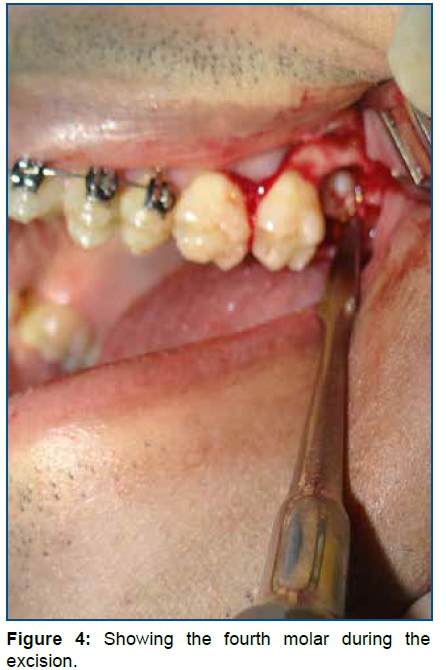
Following surgical procedures, with anesthesia via regional block of the upper posterior alveolar nerves, anterior and medial, in addition to the larger palatal nerves, tooth 28 and the ST were extracted. The surgery was performed in accordance with established clinical procedures for buccomaxillofacial surgery14,15.
The patient was prescribed the following medications according clinical protocol:
Cefalexin 500 mg, 1 tablet, oral administration, 6/6 h × 7 days; diclofenac sodium 100 mg, 1 tablet, oral administration 8/8 h × 3 days; dipyrone, 35 drops, oral administration, 6/6 h, as necessary; chlorhexidine gluconate 0.12%, rinse three times daily × 7 days14.

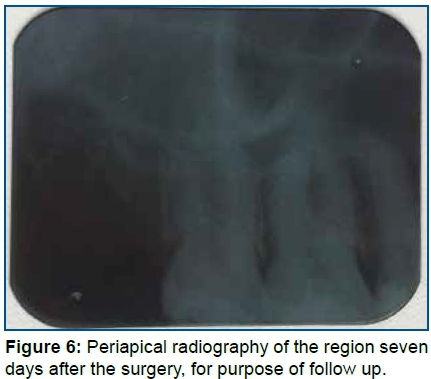
Post-surgical follow up was performed 7, 15 and 30 days after tooth extraction. The patient showed a positive evolution, without complications.
DISCUSSION
This paper describes the diagnosis and treatment of a supernumerary maxillary fourth molar.
As described by Schofield et al.,9 fourth molars, which very rarely erupt in the oral cavity, are generally only discovered through radiography, as happened in this clinical case.
Early extraction of ST is recommended if they are causing other problems such as: late eruption or failed eruption of the permanent teeth; displacement of the adjacent teeth; malocclusions; sub-acute pericoronitis; gingival inflammation; periodontal abscesses; cystic injuries; and re-absorption of roots11,14,15.
Supernumerary molars must be extracted when they cause failure of tooth eruption, misalignment of the permanent teeth, cystic injuries, sub-acute pericoronitis, gingival inflammation, or periodontal abscesses3,11. Moreover, most authors agree that extraction of ST is the preferred procedure6,16,17.
In this case, we opted for extraction of tooth 28 and the ST. We preferred to deal with this case by performing only one surgical procedure, as has been described by other authors17,18,19, to avoid additional trauma or injuries to the adjacent teeth.
No complications were observed after the surgery; however, if the teeth had remained in the oral cavity, the patient would have needed to make periodic visits to the doctor and undergo radiography for clinical management to prevent and/or minimize the risk of future problems.
CONCLUSION
Most fourth molars are diagnosed through routine radiography. The first treatment indicated is surgical extraction.
Conflict of interest
The authors declare no competing interests.
Author Contributions
All authors participated in every stage of this work, the design of the study, and writing the manuscript.
All authors agree with the final version of this manuscript.
REFERENCES
1. Shultsman M, Taicher S. Fourth molars in the maxilla and mandible-a rare phenomenon. Refuat ha-peh veha-shinayim. 2003;20(2):35. [ Links ]
2. Arslan A, et al. The frequency of distomolar teeth in a population of urban Turkish adults: a retrospective study. Oral Radiology. 2009;25(2):118-22. [ Links ]
3. Piattelli A, et al. Bilateral maxillary and mandibular fourth molars. Report of a case. Acta Stomatolol Belg.1992;89:57-60. [ Links ]
4. Koo S, et al. Bilateral maxillary fourth molars and a supernumerary tooth in maxillary canine region a case report. SADJ. 2002;57:372-74. [ Links ]
5. Pindborg JJ. Pathology of the dental hard tissues. Copenaghen: 1970. [ Links ]
6. Menardia -Pejuan V. Supernumerary molars. A review of 53 cases. It Res Sci stomatology. 2000;402(2-3):101-5. [ Links ]
7. Kokten G. Supernumerary fourth and fifth molars:A report of two cases. The journal of contemporary dental practice. 2003;4(4):67-76. [ Links ]
8. Ferrés-Padró Eduard, et al. A descriptive study of 113 unerupted supernumerary teeth in 79 pediatric patients in Barcelona. Med OralPatol Oral Cir Bucal. 2009;14:E146-52. [ Links ]
9. Schofield JJ. Multiple symmetrical supernumerary molar teeth. Br dent J. 1973;135:455-56. [ Links ]
10. Nagaveni N, et al. Maxillary paramolar: report of a case and literature review. Arch Orafac Sci. 2010;5:24-8. [ Links ]
11. Yashiro M. Radiographical study of supernumerary-teeth with special reference to the upper molar region.Shigaku. 1987;75:1013-1021. [ Links ]
12. Mittelman HR, et al. Fourth molars in the maxilla and mandible. Oral surgery oral med oral pathol.1963;16:1297-1300. [ Links ]
13. Nazif MM, et al. Impacted supernumerary teeth:a survey of 50 cases. J AM Demt Assoc. 1983;106:201-204. [ Links ]
14. Marzola, C. et al. Fundamentos de cirurgia buco maxilo facial. Bauru: Ed. Independente, 2005. [ Links ]
15. Marzola C. et al. Presença de um quarto molar no seio maxilar? Rev. Deontology Moderno, v. 7, n. 9, p. 9-11, set., 1980. [ Links ]
16. Weinberger BW. An introduction to the history of dentistry. St Louis. 1948 [ Links ]
17. Camilleri GE. Concomitant hypodontia and hyperdontia. Br Dent J. 1967;123:338-349. [ Links ]
18. Moore JR. Surgery of the mouth and jaws. Blackwell scientific publications; Oxford: 1985. pp. 373-75. [ Links ]
19. Szkaradkiewicz AK. et al. Supernumerary teeth in clinical practice. J Biol Earth Sci. 2011;1:M1-M5. [ Links ]
 Correspondence:
Correspondence:
vx.pereira@unifesp.br
Manuscript received: October 2018
Manuscript accepted: January 2019
Version of record online: April 2019














